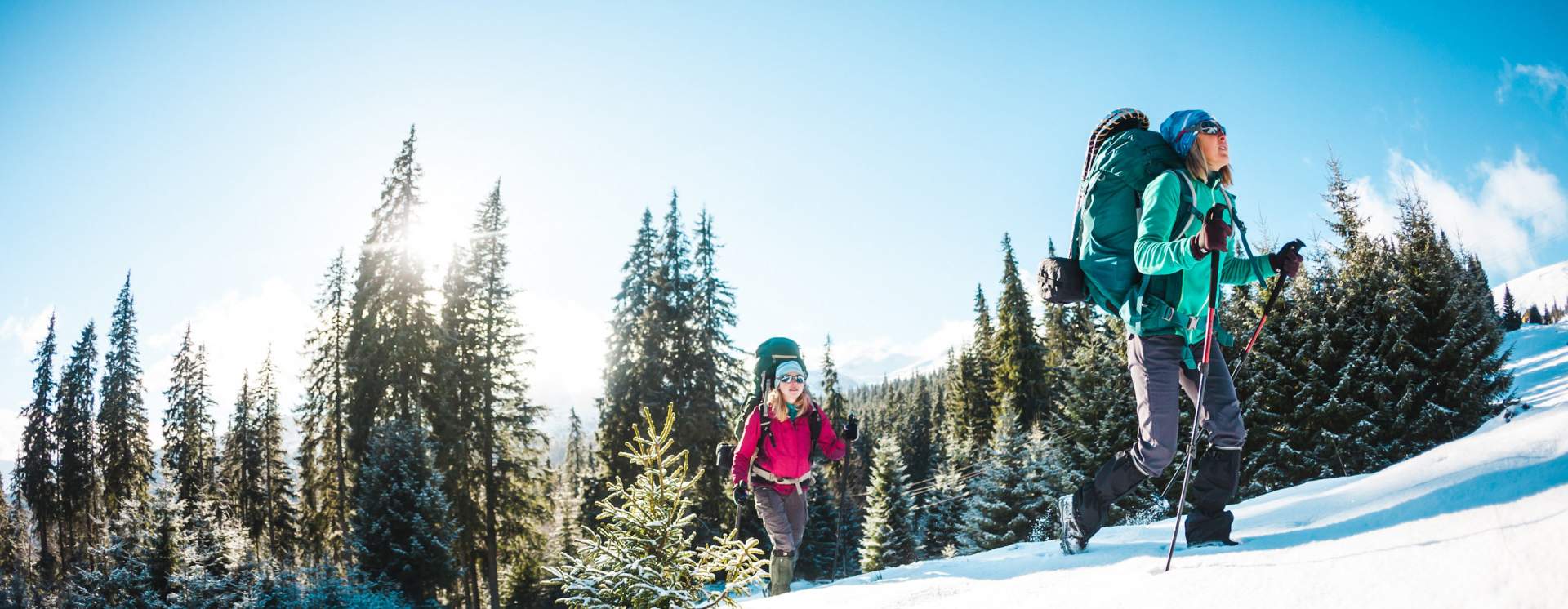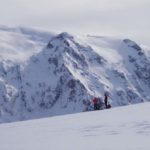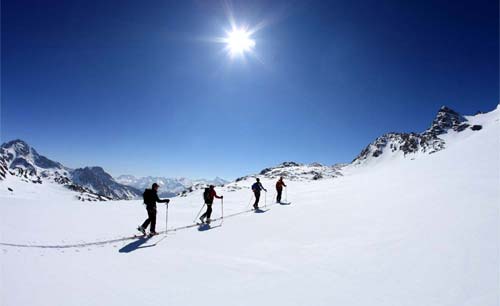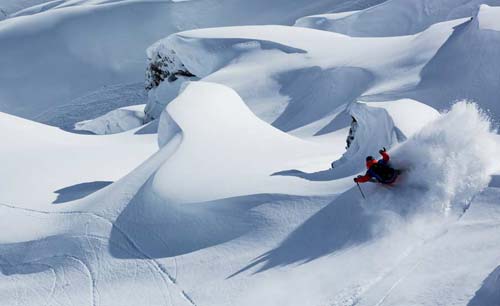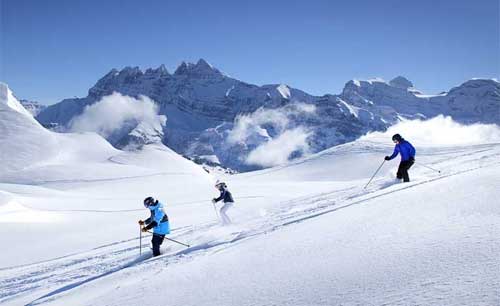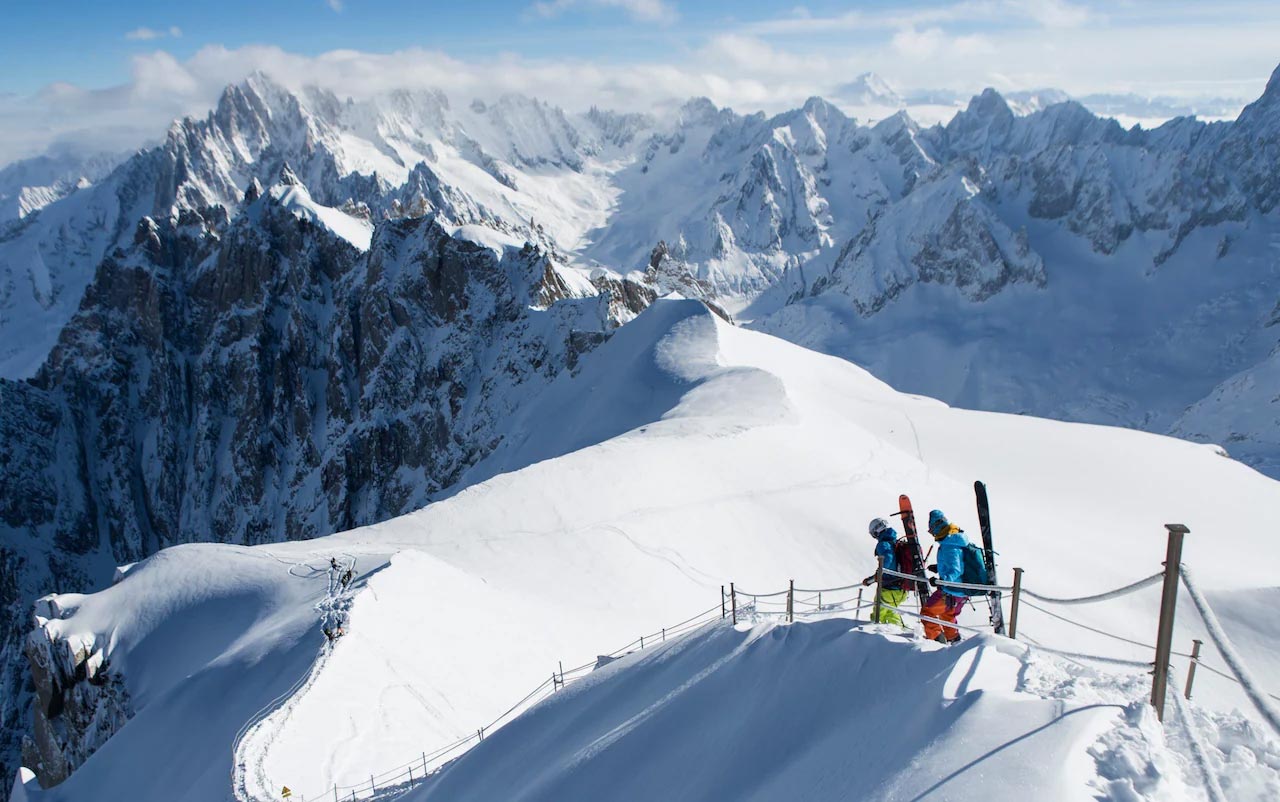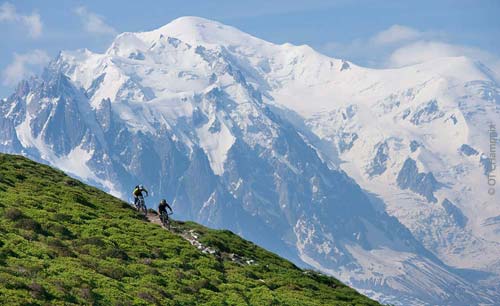A complete guide to snowshoeing in France
Experience the freedom of snowshoeing in France’s high mountain terrain far removed from the frenzy of the resorts.
Snowshoeing is a hugely satisfying way to experience the mountains, and it’s easy to do and fairly inexpensive. You can ditch the liftpass and enjoy the serenity of hiking across fields of fresh powder.
Snowshoeing in the French Alps
The French Alps Half-day full day and week-long snowshoeing expeditions, including the Tour du Mont Blanc and multi-day adventures in the Ecrins and Mercantour national parks.
Book a Snowshoeing Day Trip or Multi-Day Snowshoeing Holiday
Escape the frenzy of the resorts and strike out on a wilderness adventure amongst jagged peaks and tumbling glaciers.Half-day full day and week long expeditions including the Tour du Mont Blanc and multi-day adventures in the Ecrins and Mercantour national parks. Our snowshoeing partners use fully qualified and experienced mountain guides so you can have fun whilst staying safe.
[sabai-directory-listings category=snowshoeing featured_only=1 hide_nav=1]
A brief history of snowshoeing
Snowshoes were first used by the ancestors of Native Americans over 4000 years ago to help them cover ground on fresh snow. They were essentially refined pieces of wood, but the basic design has changed little to this day.
Traditionally, snowshoes were constructed from a single piece of white ash, which was curved into the recognisable shape. With the ends then tied together, the space inside the frame was fitted with a webbing fashioned from animal hide. Today, wood has mostly traded places with the stronger and lighter aluminium, and instead of animal hide ultrastrong copolymer webbing is used. Snowshoe designs have become sophisticated with specialist models aimed at everyone from high altitude mountaineers to snowshoeing runners.
Snowshoeing – the fastest growing winter sport!
The accessibility, short learning curve and the trend for backcountry exploration has meant snowshoeing has seen a huge jump in popularity in recent years.
Snowshoe racing is popular in both North America and Europe, with athletes like France’s Stéphane Ricard competing against 200 other competitors in the 9 km world championship race.
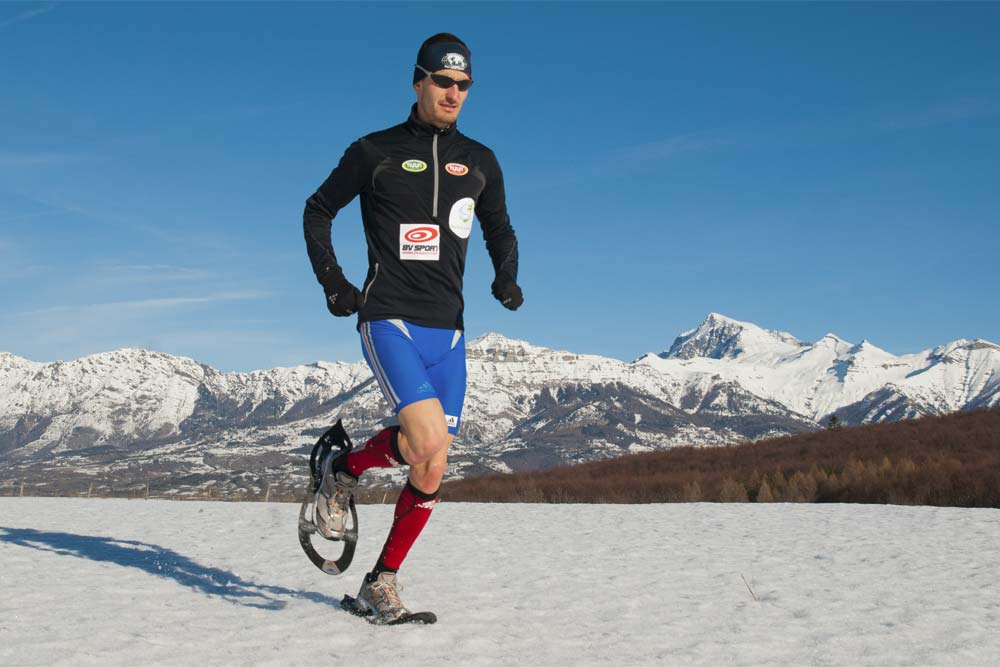
France’s Stéphane Ricard in training for the Snowshoeing World Championships | © BV Sport France
It’s a gruelling sport, the soft snow sucking the energy out of every step, but it’s a great cardiovascular workout and you can burn more than 600 calories per hour. Snowshoeing engages a wider variety of muscle groups than running as your legs need to be slightly wider apart and you’re constantly adjusting the angle of your snowshoes for maximum traction.
Snowshoeing is a key component in bootpacking where you get out of the resort into remote mountain terrain hunting for untracked powder lines to ski. With your snowshoes on and your powder skis or snowboard on your back you can access that epic off-piste terrain, without a ski lift or helicopter in sight.
Choosing Snowshoes
Snowshoes allow you to travel across snow-covered ground without sinking. By distributing your weight evenly over a large surface area, snowshoes provide enough support for you to hike, climb or even run.
Generally, the heavier the person or the lighter and drier the snow, the more snowshoe surface area is required.
Snowshoes are split into three types: flat terrain snowshoes; rolling terrain snowshoes and mountain terrain snowshoes.
Flat-terrain snowshoes are ideal for beginners, and are best for those who enjoy snowshoeing on a casual basis.
Rolling terrain snowshoes are designed for backpackers and hikers, who are more likely to explore off the beaten path. These suit most snowy conditions except extreme ice.
Mountain snowshoes are the top choice for those with more experience, looking to climb higher terrain: they feature tough bindings able to stand up to more extreme ground and conditions. While anyone just starting out on their snowshoeing hobby will be best sticking to flat-terrain snowshoes, those with history of hiking or snowboarding may well prefer to go straight for mountain terrain shoes.
Men’s snowshoes are generally crafted to suit bigger boots and more weight, while women’s are more narrow, for smaller, lighter footwear. Kids’ snowshoes are available, but finding the pair for the right age is vital – smaller ones are built for more casual use, but bigger ones suit serious snowshoeing.
Beyond comfort, making sure you pick up the right size for your needs is essential, as your snowshoes must be able to cope with the weight you carry. Your own bodyweight and the equipment you have with you is known as the carrying capacity or recommended load – a major part of making your choice.
Generally, anyone with a bigger build and a heavy back should choose snowshoes of a large size, while those of a smaller stature and a light baggage of gear will be fine to buy smaller ones. Another area you need to pay attention to are your snowshoes’ bindings, which keep your boots secured during wear (which is obviously vital – you don’t want any mishaps while climbing a steep incline!).
Bindings are typically nylon straps and a platform: the straps fit over the wearer’s foot and heel. Two different types are available.
Rotating (otherwise known as floating) bindings can pivot under the feet, where they connect to the platform – this variety may feel more natural, as the snowshoes’ tails drop with each step, which disposes of snow and easing fatigue in the legs, when walking and hiking.
Floating bindings allow for better steering when traversing deep snow, and makes tackling steep inclines somewhat easier.
Fixed bindings, on the other hand, are better for climbing over rocks, logs, and other obstructions, as the snowshoes’ tails rise with every step. These are linked with neoprene bands or rubber, and so pivot less than rotating bindings.
Before you choose between these, you should consider the type of terrain you’re likely to traverse, and the obstructions liable to litter the ground – the better-equipped you are to navigate your surroundings with ease, the more fun and relaxing your snowshoeing will be!
What about traction devices? While your own bodyweight grants a little traction (pushing the shoes into snow underfoot), snowshoes provide a better grip thanks to cleats (or crampons).
Those built for use on flat need give you only a modest degree of traction, as there’s less demand for grip on level spaces, whereas snowshoes designed for mountainous environments are fitted with stronger crampons to suit icier conditions.
Toe crampons are found under the shoes’ bindings, and pivot with you as they climb slops – this is the main traction device on all snowshoes. Heel crampons are placed under the shoes’ decking, and gather snow to slow your descent. Side rails offer greater stability, cutting side-slipping for more comfort and less risk, while braking bars reduce the chances of backsliding due to the strong forward traction they provide.
Finally, heel lifts are wire bails able to flip beneath heels – these ease strain on the calves during steep climbs, and make your energy go further by reducing effort. The longer you plan to spend out in the field (so to speak) in your snowshoeing adventures, the more robust and comfortable your snowshoes need to be. Take a look at the range available and feel free to ask all the questions you need to for your own reassurance.
What to Wear
So, you have an idea of the snowshoes you need to get the most out of your time in the backcountry or on the slopes.
What about the rest of your gear?
When it comes to footwear, you need to pick the ones best-suited to your snowshoeing preferences. For example, what if you plan to go hiking and trekking uneven terrain for hours on end? In this case, leather hiking boots (which have been waterproofed, to cope better in deep snow) are ideal. Given the added size and bulk of these, make sure your snowshoes are a good fit.
Too heavy-duty? Planning on more fitness-related snowshoeing? Go for running shoes, which are lighter, more comfortable, and more flexible for easier ascents. Boots built for snowboarding also work wonders when snowshoeing. It goes without saying you should wear wool or wool/silk socks – those made from cotton should be avoided, as they cannot stand up to the cold, wet elements as well.
If you’re heading out into deep snow, you also need to pack gaiters, which fit around the base of your trousers to keep snow out of your boots. These are easy to put on and take off when needed, and can easily be carried with you.
While snowshoeing takes place in cold surroundings, the amount of exertion involved makes getting hot and sweaty inevitable – you should avoid wearing heavy, bulky clothes that are a struggle to remove when needed. Dress in multiple layers which can be pulled off without fuss; ideally, you should wear a merino wool baselayer (which will be breathable and insulate heat) as well as a nylon layer over it to resist wind.
Over both of these layers, you should go for a waterproof jacket with breathable materials, to keep you dry if you fall into deep snow (not only will getting wet leave you uncomfortable, it will also lower your body temperature, posing severe health risks over time). As well as a jacket, waterproof trousers (or salopettes) keep you warm and dry, and can be removed very easily to reduce overheating (or when wet). A huge variety of options are on offer today.
Backcountry Snowshoeing
While we may think snowshoeing is inherently much safer than skiing, snowboarding, and other winter sports, you actually need to take great care.
To start with, one danger is the risk of getting lost, even in terrain you believe you know well. For example, if you and a friend plan on trekking through backcountry in an area you’ve lived for years, don’t just assume you’ll instantly be able to navigate it. The same applies for strange locations you’ve never visited – without a guidebook, map, or experienced snowshoe-enthusiast with you, you could well head into trouble.
Make sure you look into weather forecasts for your area, and take enough spare clothing if needed. When snowshoeing, you need to plan ahead, be prepared, and be as safe as possible – not only will your risk of encountering trouble decline, but you’ll have more fun if you know where you want to go and want you want to see!
Final word
Snowshoeing gets you out of the resort and into the serenity of the backcountry, and it’s fantastic exercise. It’s quick to learn and relatively inexpensive making it a great group activity. And while covering steep ground can be challenging, accessing remote mountain tops under your own steam is hugely satisfying. Backcountry exploration by its very nature can be hazardous and if you’re planning to stray of the waymarked routes, the advice as always is to take a guide – you be safer and you’ll have a lot more fun.
Please leave a comment below if you need specific advice for your Snowshoeing trip to France, or if you have any recommendations to help us improve this guide. Happy holidays!

